Bottom Watering: An Effective Technique For Watering Plants
When it comes to plant care, water is one of the essential requirements for the survival of plants. However, watering is not as simple as it sounds. Even the most expert green thumbs have a hard time mastering this skill. Too little water, and your plants will die. Too much water and your plants will die. That is why the technique of bottom watering plants has become a new hit thing among plant lovers. After reading this, you must be wondering how to bottom watering your plants. Don’t worry; we are here to help.

1. What is Bottom Watering?
As the name suggests, bottom watering is a technique in which the potted plants get water from the bottom. The pot is placed in a container filled with water which is soaked by the soil to the roots. It is also known as Reverse Watering.
1.1. Bottom Watering Vs. Top Watering
So why is there so much fuss about the bottom watering method when it is super convenient to water the plant from the top? Just take a watering can and dump water on the top surface of the soil. Both methods have their perks, but bottom watering has the edge over the top watering system due to following reasons:
- Roots are the main vessel supply system of the plant, so the reverse watering system supplies the roots first. Whereas, in top watering, if you water less, the upper soil surface will become moist and the roots most probably will not get desired water.
- During top watering, the water moist the upper soil, and the probability of fungus growth increases because of the over-moist upper layer. However, in bottom watering, the surface dries out first, but the roots get adequate water.
- Top watering is not ideal for certain plants as their leaves do not like moisture. In that case, reverse watering is suitable for such plants.
- The bottom watering system does not make a mess, while splashes are unavoidable in top watering.
- The bottom watering system causes the strength of roots; therefore, they expand and tighten in the soil. In comparison, the top watering system causes soil compaction that is not good for the roots.
- Reverse watering is the best solution for the hydrophobic soil that has stopped absorbing liquid. It helps to hydrate the soil and allows the soil to soak up water. Hence, the water reaches the roots properly.

Also Read: All About Air Plant Roots (And Why They Don’t Need Soil)
2. How to Bottom Watering Plants
The uniformly moist soil is the sole purpose of bottom watering. Plant watering is an enjoyable and comforting procedure. Watering your plant while talking to them is a pleasure for the gardener, but some important points should be kept in mind while bottom watering your plant.
2.1. Requirements For Bottom watering:
Before giving water from the bottom, it is necessary to check a few things:
- First of all, check whether your plant demands water or not. Check the soil moisture level by inserting your finger deep into the soil. If it is dry and you do not feel any moisture, it’s time to water the plant.
- Next, ensure the plant’s pot has drainage holes so the soil can soak up the water quickly.
- Make sure the soil in the pot is not compact because it will have difficulty absorbing and transferring water to the roots.
- Choose a lightweight watering container so it is portable and easy to handle. Otherwise, it will become tough for you to carry it to the plant.
- Use distilled water because tap water contains a high quantity of chlorine. When the top soil surface dries after watering, the minerals in tap water can cause salt to build up on the top.

2.2. Bottom Watering the Plants: Step-By-Step
After you have made all the necessary preparations and fulfilled all the requirements, move to the most important step, i.e., bottom water the potted plants.
Step 1:
Fill the container with water. The water level depends on the size of the pots you are watering. For a group of 6-8 inch pots, pour 1/2 to 2 inches of water into the container. Whereas, if the plant is large, like 10-14 inches, then 3 inches of water in the container will be sufficient. The sink or bathtub is perfect for bottom watering if you have a hefty plant or more than one plant.
Step 2:
Place your pot in the container filled with water and wait at least 10-15 minutes. Keep a check on the moisture level. The absorption time varies according to the size of the pot and the type of potting mix.
Step 3:
When you feel the top surface of the soil is moist, it’s time to take the pots out of the water.
Step 4:
Drainage of excess water is very important after bottom watering. After removing the plant from the water container or sink, place the pot in another tray for 10-15 minutes so the excess water drains away from the drain holes.
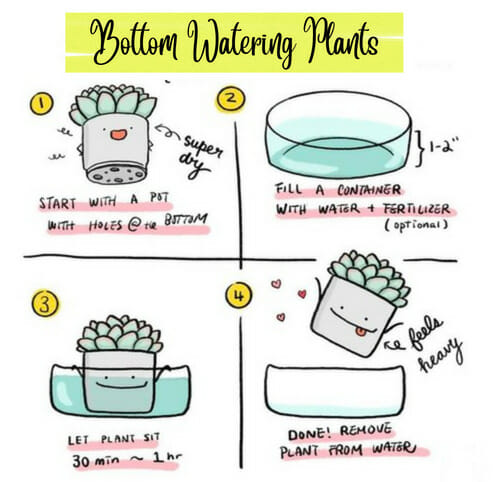
3. Is Bottom Watering Good For Plants?
Every method has some benefits on the one hand and disadvantages on the other hand.
3.1. Benefits of Bottom Watering Plants
The reverse watering system is a highly effective and easy technique for even clumsy gardeners. This method has many perks and benefits for plant lovers.
Strengthen the soil: The roots become stronger as they automatically grow in the water direction. Healthy roots supply nutrients to the plant more accurately.
Consistent watering: One of the significant benefits of bottom watering is consistent water supply to the plant. By this method, plants get even distribution of water. The soil does not have any dry spots as in top watering because water is slowly absorbed from the bottom and evenly reaches every part of the plant.
Prevent over and under watering: There is always a risk of too much or too little water in top watering. The reverse watering method saves the plant from both troubles. However, there is a chance but less than in top watering.
Reduces the chance of pest attack: Since the top of the soil never gets damp, the risk of pests and insects is also reduced. Pests thrive in moist conditions, but the dry soil layer keeps the pests away.
Keep the leaves dry: Some plants hate to get water on their leaves. American violets’ leaf discoloration is common when watered from the top. Keeping the leaves dry is very important for the plant. This method saves the leaves from wetting.
Mess-free: Top watering creates a lot of mess like splashes and spills on the nearby plant and surface. Since water is confined to a container in bottom watering, the mess reduces significantly.
Super easy: It is easier to water your plant once or twice a week than to water it daily. It saves your time and makes it easy for the plant to get healthy nutrients quickly.
Who wouldn’t like to treat his plant this way by reading all these benefits?

3.2. Disadvantages of Bottom Watering:
Bottom Watering is beneficial for plants, but some disadvantages can be a concern for some plant people.
Salt Buildup: Continous bottom watering from the bottom to the top can result in salt buildup at the top. Tap water has chlorine and other minerals. So if you use tap water for bottom watering, the salts are left behind after the water evaporates from the top. In top watering, the salts are usually flushed down with excessive water through drainage holes. To avoid this issue, you can use distilled water for the reverse watering method.
Time-consuming: This is a time taking process, one of the major reasons people avoid this way of watering.
Also Read: Bottom-Up Watering Stops You From Drowning Your Plants
4. How Long to Bottom Water Plant
The timing of the plant watering is very important. How long will your plant take to soak in the water thoroughly? The answer varies for different plants. Commonly, plants take approximately 10-15 minutes to absorb the water and soak it in the potting soil. After 10-15 minutes, insert a finger into the soil, and you will automatically observe the moisture in the soil. Some large plants may take a long time to get their bottom watered correctly. So wait for a little longer, depending upon the type and size of the plant.
5. Which Plants Like Bottom Watering
There is a long list of plants that do not like top watering. Besides, most plants do not like overwatering too. Among these plants, succulents are famous. These plants do not like taking extra water in. The water discolors the leaves of many plants, e.g., African violets.
Below is the list of plants that do not like watering from the top. The bottom watering method is best to save your plants from spots and discoloration. Many plants like the bottom water hydration system and some of these chosen plants from the long list are:
- African Violets
- Pothos
- Jade Plants
- Succulents
- Philodendron
- Peace Lily
- Purple Oxalis
- Calathea
- Snake Plant
- Cape Primrose
If you have any of these indoor plants in your little garden, show them your love with the fruitful reverse watering method. Just enhance your plant life with this simple technique.
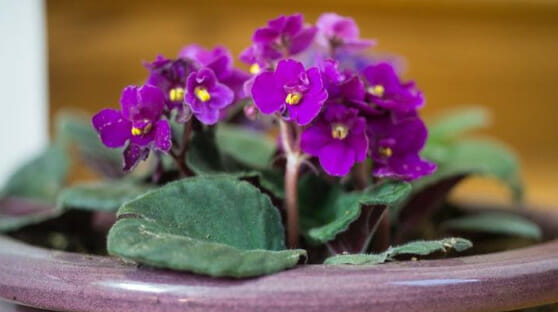
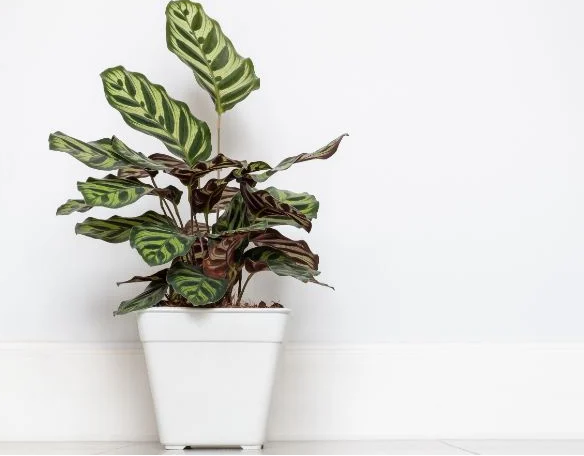


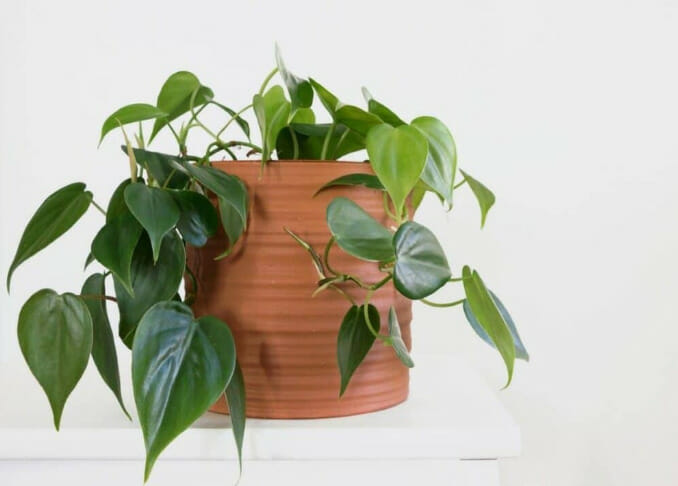
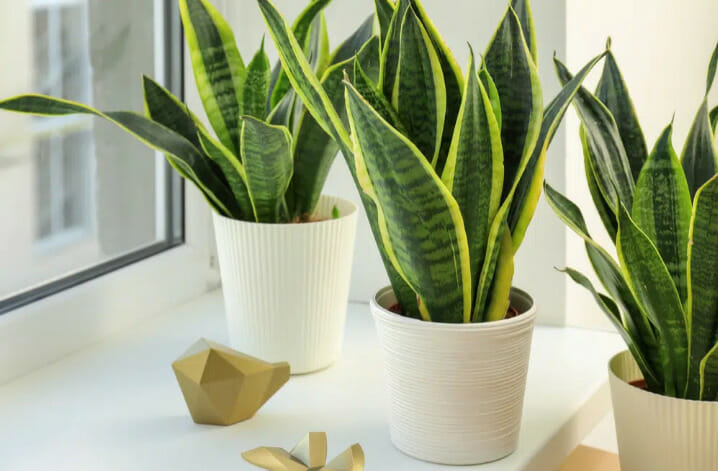
6. Recommended Products for Bottom Watering:
Bottom watering is very convenient, and you can utilize the things available at home without buying any new equipment.
- Self-Watering Pots:
Specially designed self-watering pots are available in the market. You can buy individually for each plant and save the hassle of taking the container to the plant and watering.
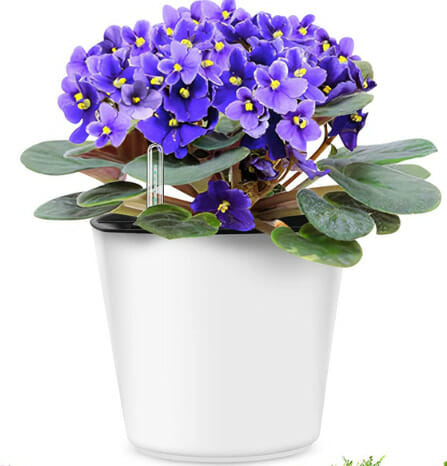
7-inch Self-watering Flower Pot (Pack of 6)
- Set of 6 pots
- Made of high-quality recycled material
- Can work for 1-2 weeks with a full reservoir
- It comes with a water indicator level
Related Article: Are Self-Watering Pots Good for Indoor Plants?
Related Article: 10 Best Indoor Self-watering Pots for Your Plants
2. Plant Tray
You can use this plant tray for small pots as it is convenient to use and you will not have to lift a heavy container filled with water on every watering.

10-Pack Plant Trays Without Holes
- Pack of 10 trays
- Made from reusable and recyclable material.
- Ideal for catching excess water that drains from pots.
Conclusion
Bottom watering is a practicing technique, and as a newbie in gardening, this method is highly effective. Let’s not bother the plant with unnecessary or no water. Adjust the water in the pot, and let the plant take it accordingly. The plant roots will drink water timely according to their thirst. Try this method today and increase your plant life.
If you found this article helpful, visit our website for more plant care tips.
